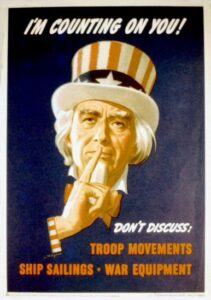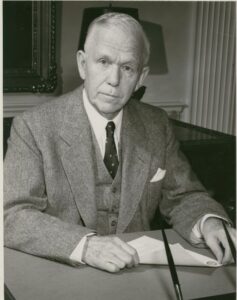My intern, Eryn, asked me the other day when “Uncle Sam” began referring to the United States, and I wasn’t sure of an answer.
Time to research!
No one seems certain about when Uncle Sam was invented, but there is good information on when he appeared in print. A 1908 article in Proceedings of the American Antiquarian Society by Albert Matthews discovered that the phrase “Uncle Sam” as a nickname for the United States appeared during the War of 1812, when this was printed in the Troy Post, “loss upon loss, and no ill luck stiring [sic], but what lights upon UNCLE SAM’S shoulders.” An explanatory note was printed with it: “this cant name for our government has got almost as current as ‘John Bull.’ The letters U. S. on the government waggons [sic] &c. are supposed to have given rise to it.”
Attributing Uncle Sam to butcher Samuel Wilson first appeared in print in John Frost’s Book Of The Navy: Comprising A General History Of The American Marine in 1842. Samuel Wilson, of Troy, NY, was locally known as “Uncle Sam.” He and his brother Ebeneezer supplied great quantities of beef and pork preserved in barrels stamped U.S. during the War of 1812. Someone asked what the U.S. stood for, and as a joke, one of the employees said, “Uncle Sam.” This joke got passed on during the latter part of the war. It was repeated over and over in the next years, appearing among other places in Bartlett’s Dictionary of Americanisms in 1848. Matthews’ article pointed out that the Uncle Sam legend did not appear in Samuel Wilson’s obituary in 1854, however.
Turns out the Troy Post use was not the first to refer to Uncle Sam. The USS Constitution Museum in Massachusetts has a journal by Midshipman Isaac Mayo, “Private Journal at Sea, 1809 to 1819,” in which he wrote in 1810, “weighed anchor stood down the harbour, passed Sandy Hook, where there are two light-houses, and put to sea, first and second day out most deadly seasick, oh could I have got on shore in the hight [sic] of it, I swear that uncle Sam, as they call him, would certainly forever have lost the services of at least one sailor.” In the Navy at least, “Uncle Sam” referring to the government was not new.
What Uncle Sam looked like was cemented by cartoonist Thomas Nash in the 1870s, although according to a National Geographic article, drawings of Uncle Sam had appeared long before.

The lightning speed of honesty by Thomas Nash in 1877. Public domain.
Artist James Montgomery Flagg further refined the look of Uncle Sam for World War I posters.

Poster by James Montgomery Flagg in 1917.
At the beginning of World War II, it was decided that Uncle Sam’s look needed to be updated, based on Flagg’s earlier depiction.
Robert Sloan created a new Uncle Sam poster, but it was decided that it looked too much like Gen. George Marshall, and artist Leon Helguera was asked to redesign the poster with this familiar result.

Uncle Sam poster by Leon Helguera.
This is the original Sloan poster. What do you think? Does it look like Marshall? Weigh in @MelissasLibrary on Twitter.

Robert Sloan poster of Uncle Sam that was never produced. National Archives photo.
 Before becoming director of library and archives at the George C. Marshall Foundation, Melissa was an academic librarian specializing in history. She and her husband, John, have three grown children, and live in Rockbridge County with three large rescue dogs. Melissa is known as the happiest librarian in the world! Keep up with her @MelissasLibrary.
Before becoming director of library and archives at the George C. Marshall Foundation, Melissa was an academic librarian specializing in history. She and her husband, John, have three grown children, and live in Rockbridge County with three large rescue dogs. Melissa is known as the happiest librarian in the world! Keep up with her @MelissasLibrary.
